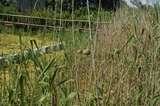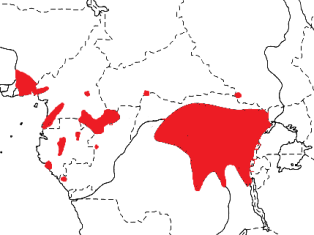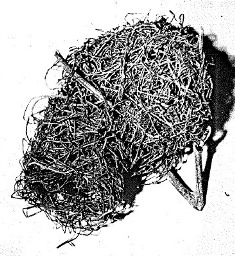Weaver species
Choose different species from drop-down list and press 'Go' button. See Full species list.Red-bellied Malimbe Malimbus erythrogaster
IUCN: Least concern Discovery: 096Categories: long tube, cooperative, Malimbus, fruit,
News items about species
Discovery
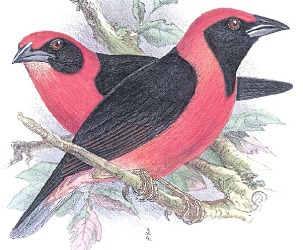
figure from Reichenow (1896) 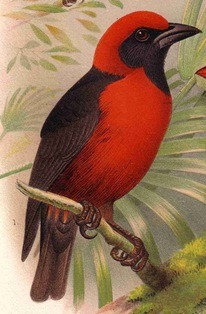
figure from Ogilvie-Grant (1910) 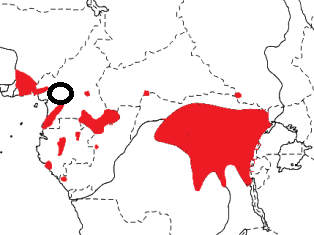
distribution, type locality circled IntroductionThe Red-bellied Malimbe was formally described by Anton Reichenow, a German ornithologist and herpetologist.The Red-bellied Malimbe was collected by Georg August Zenker, a German zoologist and botanist. In 1886 Zenker accompanied Italian explorers on an expedition to the lower reaches of the Congo River, where he then settled on a plantation in Gabon. The company had to give up the plantation in 1889, so the company owner made Zenker head of the research station at Yaounde in the interior of Cameroon - Zenker remained here from 1889-1895. Zenker collected 5000 plant specimens and a number of birds which were sent to the Berlin Museum. Zenker collected two Red-bellied Malimbes, a male and a female, sometime between 1889 and 1893, probably closer to 1893. The types are in the Berlin Museum. Zenker also collected the Yellow-capped Weaver in the same time period but probably before the Red-bellied Malimbe as the weaver was described first. The first illustration of the Red-bellied Malimbe was of the type male and female, published by Reichenow (1896). The next illustration was by Ogilvie-Grant 1910 of the male. Scientific citationMalimbus erythrogaster Reichenow 1893c, Orn. Monatsb., 1, p.205, Jaunde, Cameroon.Meaning of nameserythrogaster, Greek: Eruthros, red; gaster, the belly.First English nameRed-breasted Malimbe (Shelley 1905b).Alternate namesRed-bellied Weaver, Red-breasted Malimbe, Semliki Red-bellied Malimbe.CollectorGeorg August Zenker.Date collectedBetween 1889-1893.Locality collectedJaunde, Cameroon.Type specimensThe types are in the Berlin Museum (ZMB_31798, ZMB_31799). |
The above is based on Weaver Wednesday 2, a weekly series about the discovery of each weaver species.
This species text first appeared as
Weaver Wednesday [213] - Discovery [96]: Red-bellied Malimbe on 2016-07-13
1. Basic biology

figure from Reichenow 1896 The female is similar to the male but has a orange-red chin and throat, and is paler below. The juvenile is duller and browner than the female. Distribution. The Red-bellied Malimbe is found in Nigeria, Cameroon, Central African Republic, Equatorial Guinea, Gabon, PRCongo, and DRCongo (see map below, based on Birds of Africa). There are no subspecies and the Red-bellied Malimbe is poorly known. Habitat. The Red-bellied Malimbe inhabits high canopy in the interior of dense lowland forest, keeping at least 25 m from the forest floor. It also occurs in open dry forest and secondary forest. It is usually in pairs or small family parties. The Red-bellied Malimbe joins mixed-species foraging flocks. It regularly perches on dead branches at the top of trees.
Food.
The Red-bellied Malimbe feeds on insects including beetles, caterpillars, bugs, grasshoppers and their eggs. It also feeds on small snails, some fruit and some small seeds. It forages in open tops of emergents and in thinly leaved trees, amongst clusters of dead leaves, and on dead branches and trunks.
Breeding. The Red-bellied Malimbe is usually a solitary nester but may be colonial. It appears to have helpers at the nest. The nest is a well-woven globular chamber with an entrance tube 18cm long. The nest is placed very high in forest, in thick outer foliage, or attached to branches of tall trees. It is woven of pieces of small vines. The long spout seems to be added during the rearing of the young. The eggs are unknown, and nothing else is known about its breeding habits. Nests may be clustered in the same tree as the nest of Crowned Eagles Stephanoaetus coronatus, which provides protection from monkeys. |
The above is based on Weaver Wednesday, a weekly series about weaver species.
This species text first appeared as
Weaver Wednesday [112]: Red-bellied Malimbe on 2014-08-06
2. Breeding facts
| Pair bond Monogamous Breeding season Jul in Nigeria, Feb-Mar in Cameroon and Gabon, and Dec in PRCongo; in DRCongo, Mar in Itombwe and Mar-Apr and Aug-Sept in Ituri region Nest site attached to outer leafy branch high in canopy Nest building no information Colony size Solitary nester in Nigeria, and small colonies up to 20 nests reported in DRCongo Clutch size no information Egg colour no information Egg size no information Incubation no information Chicks and nestling period no information |
Breeding information based on Handbook of the Birds of the World, Vol. 15.
3. Photos of Weaver Nests
No records yet - be the first to submit a PHOWN record!See PHOWN summary page for this species here.
PHOWN (Photos of Weaver Nests) provides valuable info on breeding distribution and colony sizes of weavers.
You can contribute by registering and submitting photos at Virtual Museum webpage.
4. Breeding distribution
Google map showing distribution (For species with small ranges you need to zoom in at the correct area to see the range):
yellow blob - range of weaver species; read more about this here.
![]() - PHOWN records with photos
- PHOWN records with photos
![]() - PHOWN records with no photos (Nest Record Cards, other records)
- PHOWN records with no photos (Nest Record Cards, other records)
![]() - Birdpix records
- Birdpix records
![]() - comments on out of range records, or interesting records
- comments on out of range records, or interesting records
![]() - type locality
- type locality
CLICK on the marker on the map to see individual record details.
5. Range changes
Not South African speciesThe above is based on Weaver Wednesday 3, a weekly series about range changes in South African weaver species.
This species text first appeared as
n/a








